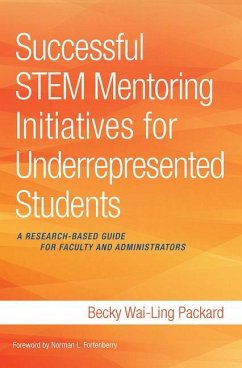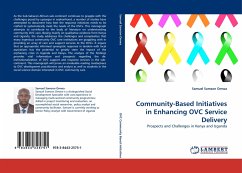Becky Wai-Ling Packard
Successful STEM Mentoring Initiatives for Underrepresented Students
A Research-Based Guide for Faculty and Administrators
Becky Wai-Ling Packard
Successful STEM Mentoring Initiatives for Underrepresented Students
A Research-Based Guide for Faculty and Administrators
- Broschiertes Buch
- Merkliste
- Auf die Merkliste
- Bewerten Bewerten
- Teilen
- Produkt teilen
- Produkterinnerung
- Produkterinnerung
Successful STEM Mentoring Initiatives for Underrepresented College Students is a step-by-step, research-based guide for higher education faculty and administrators who are charged with designing mentoring programs to recruit and retain students from underrepresented groups.
Andere Kunden interessierten sich auch für
![Designing Transformative Multicultural Initiatives Designing Transformative Multicultural Initiatives]() Designing Transformative Multicultural Initiatives49,99 €
Designing Transformative Multicultural Initiatives49,99 €![Teaching Across Cultural Strengths Teaching Across Cultural Strengths]() Alicia Fedelina ChávezTeaching Across Cultural Strengths49,99 €
Alicia Fedelina ChávezTeaching Across Cultural Strengths49,99 €![Community Based-Family Centered Initiatives to Care & Support Children Community Based-Family Centered Initiatives to Care & Support Children]() Betelihem AbrahamCommunity Based-Family Centered Initiatives to Care & Support Children34,99 €
Betelihem AbrahamCommunity Based-Family Centered Initiatives to Care & Support Children34,99 €![Community-Based Initiatives in Enhancing OVC Service Delivery Community-Based Initiatives in Enhancing OVC Service Delivery]() Samuel Samson OmwaCommunity-Based Initiatives in Enhancing OVC Service Delivery46,99 €
Samuel Samson OmwaCommunity-Based Initiatives in Enhancing OVC Service Delivery46,99 €![Language, Culture, and Identity among Minority Students in China Language, Culture, and Identity among Minority Students in China]() Yuxiang WangLanguage, Culture, and Identity among Minority Students in China209,99 €
Yuxiang WangLanguage, Culture, and Identity among Minority Students in China209,99 €![The Role of English Teaching in Modern Japan The Role of English Teaching in Modern Japan]() Mieko YamadaThe Role of English Teaching in Modern Japan209,99 €
Mieko YamadaThe Role of English Teaching in Modern Japan209,99 €![A Critical Examination of STEM A Critical Examination of STEM]() Chet BowersA Critical Examination of STEM72,99 €
Chet BowersA Critical Examination of STEM72,99 €-
-
-
Successful STEM Mentoring Initiatives for Underrepresented College Students is a step-by-step, research-based guide for higher education faculty and administrators who are charged with designing mentoring programs to recruit and retain students from underrepresented groups.
Hinweis: Dieser Artikel kann nur an eine deutsche Lieferadresse ausgeliefert werden.
Hinweis: Dieser Artikel kann nur an eine deutsche Lieferadresse ausgeliefert werden.
Produktdetails
- Produktdetails
- Verlag: Routledge
- Seitenzahl: 158
- Erscheinungstermin: 17. Dezember 2015
- Englisch
- Abmessung: 229mm x 152mm x 9mm
- Gewicht: 240g
- ISBN-13: 9781620362969
- ISBN-10: 1620362961
- Artikelnr.: 42908165
- Herstellerkennzeichnung
- Libri GmbH
- Europaallee 1
- 36244 Bad Hersfeld
- gpsr@libri.de
- Verlag: Routledge
- Seitenzahl: 158
- Erscheinungstermin: 17. Dezember 2015
- Englisch
- Abmessung: 229mm x 152mm x 9mm
- Gewicht: 240g
- ISBN-13: 9781620362969
- ISBN-10: 1620362961
- Artikelnr.: 42908165
- Herstellerkennzeichnung
- Libri GmbH
- Europaallee 1
- 36244 Bad Hersfeld
- gpsr@libri.de
Becky Wai-Ling Packard is Professor of Psychology and Education at Mount Holyoke College, and has studied mentoring, diversity, and STEM persistence for 20 years. A trusted resource in the field, Packard has provided expert consulting to a variety of campuses in addition to state-level and national-level audiences. In 2005, she earned the federal government's top honor for early career scientists, the Presidential Early Career Award for Scientists and Engineers. Her work has been funded by the National Science Foundation and Google. A first-generation college graduate and person of color, Packard completed the Summer Research Opportunity Program and earned her bachelor's degree from the University of Michigan-Ann Arbor. In 1999, after she earned her Ph.D. from Michigan State University, she joined the faculty at Mount Holyoke College. On her campus, she has led leadership, mentoring, and faculty teaching initiatives in her capacity as the Director of the Harriet L. and Paul M. Weissman Center for Leadership.
Acknowledgements Foreword Introduction:
Why do we need to recruit students into STEM and help them persist?
Why is diversity in STEM valuable?
Why is mentoring a worthy investment for STEM departments?
What will you gain from this book? 1. Map the Landscape, Choose a Focus
Map the landscape using the ecological model
Primary factors influencing persistence. Obstacles and opportunities
The big picture. The learning environment and department climate
Reader next steps. Choose a focus 2. Mentoring With Intention. What's Your Strategy?
Intentional mentoring
Approaches to mentoring
Making decisions. Intensity and selectivity
Start small with a pilot
Reader next steps. Create a road map 3. What Works (and Why. During the Transition to College
What works and why
Improving the departmental climate for new students
Case study with Bill Gomez
Reader next steps. Explore your options during the transition to college 4. What Works (and Why. During the Transition to a STEM major
What works and why
Improving departmental climate for prospective and current majors
Case study with Susan Mason
Reader next steps. Explore your options during the transition to a STEM major 5. What Works (and Why. During the Transition to the Workplace or Graduate Studies
What Works and why
Improving departmental climate for upper-level students
Case Study with Mark Sanderson
Reader next steps. Explore your options for the transition to the workplace or graduate studies 6. Difficult Mentoring Moments. Framing Messages to Improve Impact
Why some mentoring moments are difficult
The benefits of mentor orientation sessions and other forms of practice
Reader next steps. Invest in conversations about difficult mentoring moments 7. Conversations Among Colleagues. Departmental Climate as a Collective Project
Changing climate, one conversation at a time
Tracking your progress
Reader next steps. Plan your department conversation Conclusion
Start small
The tipping point
Who do you want to be?
Reader next steps. Summarize what you have learned Resources
Professional organizations and consortia
Statistics, strategies, and tool kits
Recommended books and reports Index
Why do we need to recruit students into STEM and help them persist?
Why is diversity in STEM valuable?
Why is mentoring a worthy investment for STEM departments?
What will you gain from this book? 1. Map the Landscape, Choose a Focus
Map the landscape using the ecological model
Primary factors influencing persistence. Obstacles and opportunities
The big picture. The learning environment and department climate
Reader next steps. Choose a focus 2. Mentoring With Intention. What's Your Strategy?
Intentional mentoring
Approaches to mentoring
Making decisions. Intensity and selectivity
Start small with a pilot
Reader next steps. Create a road map 3. What Works (and Why. During the Transition to College
What works and why
Improving the departmental climate for new students
Case study with Bill Gomez
Reader next steps. Explore your options during the transition to college 4. What Works (and Why. During the Transition to a STEM major
What works and why
Improving departmental climate for prospective and current majors
Case study with Susan Mason
Reader next steps. Explore your options during the transition to a STEM major 5. What Works (and Why. During the Transition to the Workplace or Graduate Studies
What Works and why
Improving departmental climate for upper-level students
Case Study with Mark Sanderson
Reader next steps. Explore your options for the transition to the workplace or graduate studies 6. Difficult Mentoring Moments. Framing Messages to Improve Impact
Why some mentoring moments are difficult
The benefits of mentor orientation sessions and other forms of practice
Reader next steps. Invest in conversations about difficult mentoring moments 7. Conversations Among Colleagues. Departmental Climate as a Collective Project
Changing climate, one conversation at a time
Tracking your progress
Reader next steps. Plan your department conversation Conclusion
Start small
The tipping point
Who do you want to be?
Reader next steps. Summarize what you have learned Resources
Professional organizations and consortia
Statistics, strategies, and tool kits
Recommended books and reports Index
Acknowledgements Foreword Introduction:
Why do we need to recruit students into STEM and help them persist?
Why is diversity in STEM valuable?
Why is mentoring a worthy investment for STEM departments?
What will you gain from this book? 1. Map the Landscape, Choose a Focus
Map the landscape using the ecological model
Primary factors influencing persistence. Obstacles and opportunities
The big picture. The learning environment and department climate
Reader next steps. Choose a focus 2. Mentoring With Intention. What's Your Strategy?
Intentional mentoring
Approaches to mentoring
Making decisions. Intensity and selectivity
Start small with a pilot
Reader next steps. Create a road map 3. What Works (and Why. During the Transition to College
What works and why
Improving the departmental climate for new students
Case study with Bill Gomez
Reader next steps. Explore your options during the transition to college 4. What Works (and Why. During the Transition to a STEM major
What works and why
Improving departmental climate for prospective and current majors
Case study with Susan Mason
Reader next steps. Explore your options during the transition to a STEM major 5. What Works (and Why. During the Transition to the Workplace or Graduate Studies
What Works and why
Improving departmental climate for upper-level students
Case Study with Mark Sanderson
Reader next steps. Explore your options for the transition to the workplace or graduate studies 6. Difficult Mentoring Moments. Framing Messages to Improve Impact
Why some mentoring moments are difficult
The benefits of mentor orientation sessions and other forms of practice
Reader next steps. Invest in conversations about difficult mentoring moments 7. Conversations Among Colleagues. Departmental Climate as a Collective Project
Changing climate, one conversation at a time
Tracking your progress
Reader next steps. Plan your department conversation Conclusion
Start small
The tipping point
Who do you want to be?
Reader next steps. Summarize what you have learned Resources
Professional organizations and consortia
Statistics, strategies, and tool kits
Recommended books and reports Index
Why do we need to recruit students into STEM and help them persist?
Why is diversity in STEM valuable?
Why is mentoring a worthy investment for STEM departments?
What will you gain from this book? 1. Map the Landscape, Choose a Focus
Map the landscape using the ecological model
Primary factors influencing persistence. Obstacles and opportunities
The big picture. The learning environment and department climate
Reader next steps. Choose a focus 2. Mentoring With Intention. What's Your Strategy?
Intentional mentoring
Approaches to mentoring
Making decisions. Intensity and selectivity
Start small with a pilot
Reader next steps. Create a road map 3. What Works (and Why. During the Transition to College
What works and why
Improving the departmental climate for new students
Case study with Bill Gomez
Reader next steps. Explore your options during the transition to college 4. What Works (and Why. During the Transition to a STEM major
What works and why
Improving departmental climate for prospective and current majors
Case study with Susan Mason
Reader next steps. Explore your options during the transition to a STEM major 5. What Works (and Why. During the Transition to the Workplace or Graduate Studies
What Works and why
Improving departmental climate for upper-level students
Case Study with Mark Sanderson
Reader next steps. Explore your options for the transition to the workplace or graduate studies 6. Difficult Mentoring Moments. Framing Messages to Improve Impact
Why some mentoring moments are difficult
The benefits of mentor orientation sessions and other forms of practice
Reader next steps. Invest in conversations about difficult mentoring moments 7. Conversations Among Colleagues. Departmental Climate as a Collective Project
Changing climate, one conversation at a time
Tracking your progress
Reader next steps. Plan your department conversation Conclusion
Start small
The tipping point
Who do you want to be?
Reader next steps. Summarize what you have learned Resources
Professional organizations and consortia
Statistics, strategies, and tool kits
Recommended books and reports Index








